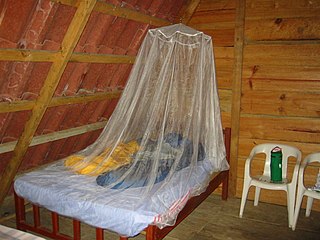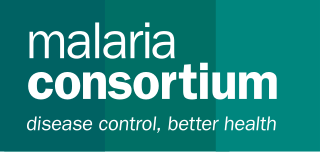Related Research Articles

Dichlorodiphenyltrichloroethane, commonly known as DDT, is a colorless, tasteless, and almost odorless crystalline chemical compound, an organochloride. Originally developed as an insecticide, it became infamous for its environmental impacts. DDT was first synthesized in 1874 by the Austrian chemist Othmar Zeidler. DDT's insecticidal action was discovered by the Swiss chemist Paul Hermann Müller in 1939. DDT was used in the second half of World War II to limit the spread of the insect-borne diseases malaria and typhus among civilians and troops. Müller was awarded the Nobel Prize in Physiology or Medicine in 1948 "for his discovery of the high efficiency of DDT as a contact poison against several arthropods".

Malaria is a mosquito-borne infectious disease that affects humans and other animals. Malaria causes symptoms that typically include fever, tiredness, vomiting, and headaches. In severe cases, it can cause jaundice, seizures, coma, or death. Symptoms usually begin ten to fifteen days after being bitten by an infected mosquito. If not properly treated, people may have recurrences of the disease months later. In those who have recently survived an infection, reinfection usually causes milder symptoms. This partial resistance disappears over months to years if the person has no continuing exposure to malaria.

Epidemiology is the study and analysis of the distribution, patterns and determinants of health and disease conditions in a defined population.
Tropical diseases are diseases that are prevalent in or unique to tropical and subtropical regions. The diseases are less prevalent in temperate climates, due in part to the occurrence of a cold season, which controls the insect population by forcing hibernation. However, many were present in northern Europe and northern America in the 17th and 18th centuries before modern understanding of disease causation. The initial impetus for tropical medicine was to protect the health of colonial settlers, notably in India under the British Raj. Insects such as mosquitoes and flies are by far the most common disease carrier, or vector. These insects may carry a parasite, bacterium or virus that is infectious to humans and animals. Most often disease is transmitted by an insect bite, which causes transmission of the infectious agent through subcutaneous blood exchange. Vaccines are not available for most of the diseases listed here, and many do not have cures.

In epidemiology, an infection is said to be endemic in a specific population or populated place when that infection is constantly maintained at a baseline level without extra infections being brought into the group as a result of travel or similar means. An endemic disease always has a steady, predictable number of people getting sick, but that number can be high (hyperendemic) or low (hypoendemic), and the disease can be severe or mild. Also, a disease that is usually endemic can become epidemic.
Mathematical models can project how infectious diseases progress to show the likely outcome of an epidemic and help inform public health and plant health interventions. Models use basic assumptions or collected statistics along with mathematics to find parameters for various infectious diseases and use those parameters to calculate the effects of different interventions, like mass vaccination programs. The modelling can help decide which intervention(s) to avoid and which to trial, or can predict future growth patterns, etc.

A mosquito net is a type of meshed curtain that is circumferentially draped over a bed or a sleeping area, to offer the sleeper barrier protection against bites and stings from mosquitos, flies, and other pest insects, and thus against the diseases they may carry. Examples of such preventable insect-borne diseases include malaria, dengue fever, yellow fever, zika virus, Chagas disease and various forms of encephalitis, including the West Nile virus.
The Malaria Atlas Project, abbreviated as MAP, is a non-profit academic group led by Professor Peter Gething, Kerry M Stokes Chair in Child Health, at the Telethon Kids Institute, Perth, Western Australia. The group is funded by the Bill and Melinda Gates Foundation, with previous funding also coming from the Medical Research Council and the Wellcome Trust. MAP aims to disseminate free, accurate and up-to-date information on malaria and associated topics, organised on a geographical basis. The work of MAP falls into three areas:

Bendiocarb is an acutely toxic carbamate insecticide used in public health and agriculture and is effective against a wide range of nuisance and disease vector insects. Many bendiocarb products are or were sold under the tradenames "Ficam" and "Turcam."

Indoor residual spraying or IRS is the process of spraying the inside of dwellings with an insecticide to kill mosquitoes that spread malaria. A dilute solution of insecticide is sprayed on the inside walls of certain types of dwellings—those with walls made from porous materials such as mud or wood but not plaster as in city dwellings. Mosquitoes are killed or repelled by the spray, preventing the transmission of the disease. In 2008, 44 countries employed IRS as a malaria control strategy. Several pesticides have historically been used for IRS, the first and most well-known being DDT.

Malaria Consortium is an international non-profit organization specializing in the comprehensive control of malaria and other communicable diseases – particularly those affecting children under five.

The administration of drugs to whole populations irrespective of disease status is referred to as mass drug administration (MDA).
Garki is a Local Government Area of Jigawa State, Nigeria. Its headquarters are in the town of Garki. It is also called Garkin Dirani, the name of the head of the district.
The Center for Disease Dynamics, Economics & Policy (CDDEP) is a public health research organization with headquarters in Washington, D.C. and New Delhi. Its mission is "to produce independent, multidisciplinary research to advance the health and well-being of human populations in the United States and around the world."

malariacontrol.net was a volunteer computing project to simulate the transmission dynamics and health effects of malaria. It was part of the Africa@home project.

Ira M. Longini is an American biostatistician and infectious disease epidemiologist.
The Innovative Vector Control Consortium (IVCC) is a not-for-profit, product development partnership (PDP) designed to facilitate the development and delivery of new and improved vector control tools to prevent malaria and other neglected tropical diseases. Their mission is to save lives, protect health and increase prosperity in areas where disease transmitted by insects is endemic.
Obinna Emmanuel Onwujekwe is a Nigerian medical doctor who serves as Professor of Health Economics and Policy and Pharmacoeconomics in the Departments of Health Administration & Management and Pharmacology and Therapeutics, College of Medicine, based in University of Nigeria.
Azra Catherine Hilary Ghani is a British epidemiologist who is a professor of Infectious Disease Epidemiology at Imperial College London. Her research considers the mathematical modelling of infectious diseases, including malaria, bovine spongiform encephalopathy and coronavirus. She has worked with the World Health Organization on their technical strategy for malaria. She is associate director of the MRC Centre for Global Infectious Disease Analysis.

George Macdonald was a British physician who was Professor of Tropical Hygiene at the London School of Hygiene & Tropical Medicine. His research concentrated primarily on malaria, its epidemiology and control. He was the author of many papers on the mathematical analysis of transmission of tropical infections and the author of The Epidemiology and Control of Malaria, published in 1957.
References
- ↑ Molineaux, L.; Gramiccia, G. (1980). The Garki Project: Research on the Epidemiology and Control of Malaria in the Sudan Savanna of West Africa. World Health Organization. ISBN 9241560614.
- ↑ Molineaux, L.; Dietz, K.; Thomas, A. (1978). "Further Epidemiological Evaluation of a Malaria Model". Bull. World Health Organ. 56 (4): 565–71. PMC 2395644 . PMID 365384.